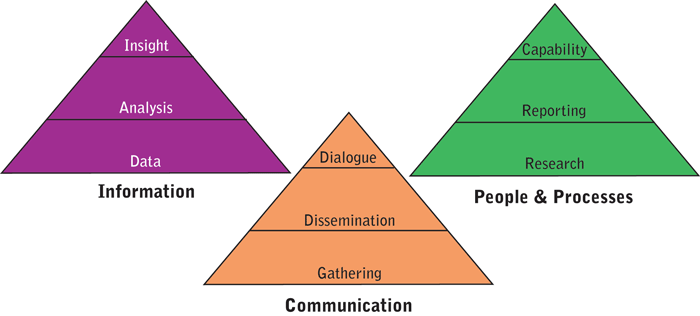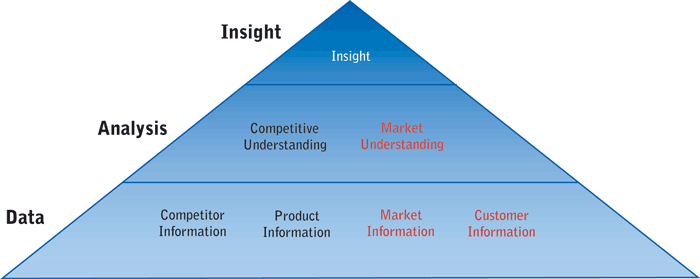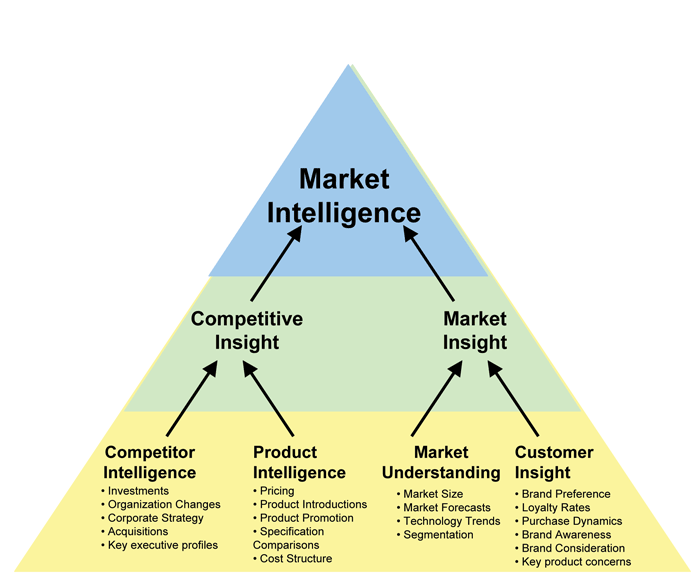Market intelligence versus marketing research
Editor’s note: Ed Crowley is worldwide printer marketing manager for Lexmark International, a Lexington, Ky.-based printer manufacturer.
Many companies use the term “market intelligence” interchangeably with the term marketing research. A search of the Internet using the term market intelligence clearly demonstrates this trend, with the search returning page after page of marketing research companies advertising their market intelligence capabilities.
So is market intelligence the same thing as market research? Absolutely not! Market research is a well-defined discipline with a long history of application in the business world. It takes many different forms, and its ultimate goal is to enhance a firm’s understanding of the market and customer, but it is not market intelligence.
Market intelligence is a much broader term that can be defined as an ongoing, holistic knowledge of all aspects of the marketplace. One way to visualize market intelligence is to picture a pyramid. Each face of the pyramid represents an aspect of market intelligence. The three faces of the pyramid are information, communication, and people/processes. Each of these faces is built upon a foundation of basic capabilities, with movement “up” the face of the pyramid representing increasing capabilities and proficiency. Market intelligence is the culmination of each of these areas at their highest levels.

The differences between marketing research and market intelligence are as follows:
- Market intelligence is all-encompassing. Data gathering is just one aspect of market intelligence. It is a key building block for the information face of the pyramid, but it is not the only building block.
- Market intelligence analysis requires different skills versus marketing research. Market intelligence analysis requires a broad set of analytical skills including business analysis skills. It requires integrating a broad array of information, which extends beyond traditional marketing research data. The analyst must understand the market, key competitors, the financial dynamics of the industry, and the entire business value chain. Often, the best market intelligence analysts have a financial or product management background, whereas many of the best marketing research analysts come from behavioral science or mathematical backgrounds.
- Market intelligence requires integration with all aspects of the business. Whereas marketing research is highly focused on customers, market analysis encompasses the entire view of the market and requires integration into the companies forecasting process, product development process, and other business systems.
The best way to discuss the difference between marketing research and market intelligence is to focus upon each face of the market intelligence pyramid. The information face of the market intelligence pyramid is built upon a foundation consisting of four basic areas: competitor information, product information, market information and customer information. This is depicted in Figure 2.

Product information refers to an understanding of the products in the marketplace, how they are priced, and what tactical marketing activities (promotions, advertising, etc.) are being used with these products. Competitor information refers to the understanding of competitors’ strategies, organizational structure, product investment portfolio, and future product plans. Market information encompasses a view of the market at a macro level including the current market size, market segments, market share trends, and the forecasted growth of the market and the respective market segments. Finally, and perhaps most importantly, customer information (the traditional focus of market research) involves fully understanding the customer preferences, drivers of customer behavior, brand loyalty, satisfaction rates and any other customer views that impact their behavior in relation to your firm’s products or services. It is important to note that each of these areas of knowledge can be a unique discipline in and of itself. However, the real power of the information lies in combining all of these areas to create a complete view of the market, the market intelligence view (Figure 3).

Market intelligence yields an ongoing and comprehensive understanding of the market. Each of the four knowledge areas - competitor intelligence, product intelligence, market understanding, customer insight - interacts to form a complete understanding of the market. Each competitor’s strategies will impact their product actions, the overall trends of market growth and segment interaction will impact the strategies, and underlying all of this, the customer’s behaviors and attitudes will ultimately drive the market dynamics in terms of growth rates and product acceptance. This integration of all four knowledge areas is the ultimate deliverable for market intelligence. Marketing research is a critical and significant source of information. However, it does not encompass all of the information areas which are covered by market intelligence. The scope of information covered is one of the key differences between marketing research and market intelligence.
When examining the communication face of the market intelligence pyramid, the most important difference between market intelligence and marketing research is that good market intelligence involves a dialogue between the market intelligence analyst and the client/decision maker. Conversely, marketing research provides an assessment of a specific issue, or measures a specific market dynamic. While it clearly involves communication with the client/decision maker, it typically consists of limited interaction versus the full dialogue of market intelligence.
The third and final face of the pyramid deals with people and processes. This can be the most defining difference between marketing research and market intelligence. By its very nature market intelligence is a process. One which constantly captures information from many difference sources, assesses it, and then uses the information during the ongoing business decision-making process.
Marketing research is typically focused on answering specific questions, or tracking specific issues. While it can benefit from good processes, it is a finite “task” (or series of tasks). Market intelligence is a process, an ongoing interactive process.
This process should be a closed-loop system with a feedback cycle from the executives to the market intelligence team. The executive’s feedback will guide the market intelligence team in future analyses by providing insight into the key issues the executives are facing. At the same time, the market intelligence teams are constantly capturing, monitoring, and synthesizing information that will ensure that the executive team is not surprised by market developments or competitive actions.
In his book Business as War, Kenneth Allard makes a parallel between the business environment and the intense and ever-changing environment associated with a battlefield. In this battlefield environment the intelligence on your enemy’s activities is vital to winning, and it must constantly be monitored and updated due to the fluid nature of the battlefield. Obviously, the stakes are lower in business versus war. We are not fighting for our lives like the brave soldiers in the field of battle.
However, we are fighting for territory (market share and customers) against multiple enemies, all of whom have strategies focused on taking territory from our firms. Building a solid market intelligence system is vital to having the information necessary to compete and win in your business battleground. If your firm’s focus is only on marketing research, your view of the battlefield is limited and potentially threatens your position in the market.
So what about all of these companies listed under the heading of “market intelligence” in our Web search? A quick examination of these companies’ Web pages reveals that most are offering a traditional set of marketing research survey services, as opposed to complete market intelligence services. While market intelligence is an oft-promised capability, frequently companies are simply delivering traditional marketing research services.
So how does one develop a true market intelligence capability? It would take much more than the space in this article to address this question. At a very high level, it involves:
- Having a vision for your market intelligence function. Do you want it to be world-class? What do you want your market intelligence function to excel in? How would you define success for your market intelligence team?
- Obtaining buy-in from your market intelligence team for your vision. This requires a clear articulation of what you are trying to accomplish, providing the team the opportunity to talk about the vision and to actually impact what the final vision is. Working as a team to craft a mission statement that clearly articulates the vision.
- Mapping your vision to a set of core competencies required to fulfill your vision. Identify the competencies that are unique and which represent significant added value by your team. Perform an audit of your market intelligence function in order to ensure your vision maps to your client’s needs, and to identify gaps between your market intelligence vision and your team’s current capabilities and deliverables. Build a plan to address and fill in the gaps, keeping in mind that this doesn’t happen overnight - it can easily be a two-to-three-year process.
- Increasing the focus on building your core market intelligence competencies by outsourcing those elements (i.e., competitive product cost tear-downs, etc.) which are not essential to the core. A great example of this is to utilize outside vendors and information distribution technologies to outsource the collection, summary and dissemination of market news data (competitor price changes, promotional activities, etc.). Another example is to use outside marketing research vendors for all non-core aspects of marketing research projects (including sourcing, fielding, project management, and basic statistical and crosstabular analysis). Then your analysts can focus on structuring the initial research project based on their understanding of the business need, and then identifying what the research results mean in the context of the business issues and decisions at hand.
- Creating a process that bridges functional groups to capture information from many different business areas to provide the information foundation for a complete market intelligence picture.
- Ensuring the market intelligence staff has a consulting versus a project management focus (which of course, has implications for the skill sets of your market intelligence staff). This includes measuring the results of decisions made based upon your market intelligence and then fine-tuning future work in order to drive better results.
- Obtaining the mandate of and access to your executive team in order to integrate the results of market intelligence analysis into the business decision-making process, and to capture the feedback, which will drive future market intelligence inquiries and analysis.
Of course, this is much easier said than done. However, with the rigorous application of market intelligence discipline, techniques and principles, you can create a true market intelligence organization that will not only be an integral part of your business decision-making process, but which will also play a key role in shaping your firm’s strategic direction.
